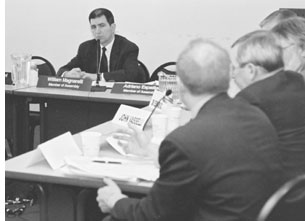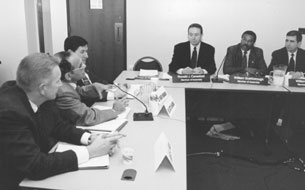
from the NYS Assembly
Task Force on
University-
Industry
Cooperation

|
A Special Report from the NYS Assembly Task Force on University- Industry Cooperation |
| Sheldon Silver, Speaker • William B. Magnarelli, Chair • August 2004 |
|
Dear Friends, As chair of the Task Force on University-Industry Cooperation, it is my pleasure to submit the third annual Task Force on University-Industry Cooperation Newsletter. As you all know, 2004 has been an intense legislative session during which we have had many challenging issues to work on and differences to resolve. The Task Force has continued to work on its issues aggressively and that our oversight and our efforts to maintain accountability among the entities competing for and receiving State funds for research and development have been carefully maintained. While the focus this year has been on oversight, we introduced and passed legislation in the Assembly that has strong economic development components. It is also extremely gratifying for me to be able to tell you that the State’s commitment to research and development has never been stronger. The resulting product commercialization will bring jobs to local New York State communities as well as exciting and potentially life altering benefits to people here and around the world. It is my goal with this newsletter to capture the highlights of the Task Force’s work during the 2004 legislative session. As always, if you have any questions or particular concerns, please do not hesitate to contact me. I want to be as responsive to your needs as possible and am always interested in your suggestions for the Task Force.
|
|
2004 Task Force Events |
Roundtable on the Centers of Excellence
Visit to the SUNY College of Environmental Science and Forestry
Roundtable on the Role of the State’s Technology Development Organizations in
Regional Economic Development |
|
Research & Development in New York State |
|
|
The Association of University Technology Managers (AUTM) conducts an annual survey of academic and other research institutions and compiles and summarizes data on research and licensing activities, allowing for comparisons between New York and other states. The Survey does not include all of the R&D activity for all institutions in any given state since there are universities and colleges that did not respond to the survey. According to the latest available survey for 2001, New York leads the nation in generating income from licensing, and is in 2nd place in total research expenditures from federal, industry and other* sources, but is fourth in attracting federal R&D dollars. New York lags far behind others, in 7th place, in attracting R&D funds from industry and is relatively weak in creating new businesses. A summary of the findings is presented below: Total Research Expenditures from All Sources
Federal Sources
* Other sources are not specified in the AUTM report, but likely include such entities as state agencies, non-profit organizations, individual donors, and university and private foundations. Industry Sources
Other Sources
License Income Received from Patents
Start-up Businesses
|
|
The first table uses an indicator that measures the extent to which a state’s workforce is employed in high-technology industries. State economies with a high value for this indicator are probably well-positioned to take advantage of new technological advances because they have a relatively larger pool of experienced high-technology workers. Although in raw numbers New York State ranks high, its high-tech employment ranking as a percent of all employment lags behind. |
|||||||||||||||||||||||||||||||||||||||||||||||||||||||||||||||||||||||
|
Employment in High-Technology Establishments
|
|||||||||||||||||||||||||||||||||||||||||||||||||||||||||||||||||||||||
|
|
|||||||||||||||||||||||||||||||||||||||||||||||||||||||||||||||||||||||
|
High-Technology Businesses As a Share of
|
|||||||||||||||||||||||||||||||||||||||||||||||||||||||||||||||||||||||
|
|
|||||||||||||||||||||||||||||||||||||||||||||||||||||||||||||||||||||||||||||||||||||
|
Venture Capital Disbursed per $1,000
|
|||||||||||||||||||||||||||||||||||||||||||||||||||||||||||||||||||||||||||||||||||||
| Assemblyman Magnarelli, Chair of the Assembly Task Force on University-Industry Cooperation poses questions during a Roundtable on the Centers of Excellence. |

|

|
Assemblyman Magnarelli, Chair of the Assembly Task Force on University-Industry Cooperation, asks questions during a roundtable discussion in Albany on the State’s Technology Development Organizations. |
|
2004 Legislation |
||||
I was proud to be part of the Speaker’s 2004 economic development agenda as presented in the Assembly’s Jobs Plan, New York @ Work, and was prime sponsor on the following bills which were submitted either as part of the Jobs Plan or as Task Force legislation.
* Last action reported as of the date that this Newsletter went to print. |
||||

|
Assemblymembers Magnarelli, Scarborough and Canestrari address Representatives during a roundtable in Albany on the Centers of Excellence. |
|
For more information, contact: Assemblyman William B. Magnarelli Chair, Assembly Task Force on University-Industry Cooperation Room 519 LOB • Albany, New York 12248 • 518.455.4826 333 East Washington St., Room 840 • Syracuse, New York 13202 315.428.9651 |
|
New York State Assembly [ Welcome Page ] [ Committee Updates ] |